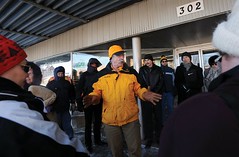A nice article on Dan Burden

Dan Burden talks with the group walking with him during the walking audit of Albert Lea on Thursday in the downtown area. Photo: Brie Cohen, Albert Lea Tribune.
Dan Burden, of Walkable Communities, is a consultant who as part of his approach and toolkit, does "walking audits" with communities looking at becoming more people-oriented and less car-oriented. This article, "Walkable audit of Albert Lea offers Bridge Avenue ideas: More lanes often create more traffic problems, expert says," from the Albert Lea Tribune in Minnesota, recounts a walk and the advice made along the way.
I like these:
Several times during the tour he mentioned road diets and mentioned cities such as Seattle that have had success with road diets. Road diets, of which Burden is a national proponent, is where traffic problems are solved by reducing lanes or lane width to increase safety.
In some places, businesses were afraid of having less traffic because of fewer lanes, but the opposite was true. Bike lanes, parking and steady, vigilant motorists resulted in increased business. ...
“If you don’t learn to see and interpret things, you don’t have a job,” Burden said. He said he learns a lot from walking and said any good designer also uses the product to see its failings.
As he entered the field of civil planning, he found when engineers designed corners, they would never have to cross the streets themselves. They were not trained to factor in the pedestrians and bicycles. “That just wasn’t part of the curriculum,” he said. Walking the streets gives people the ability to see what is right and wrong in the engineer’s design. ...
At Newton Avenue, the lack of a building on the corner cuts into the use of the sidewalk. People walk across the parking lot. He said cities need to rethink their tax structure. They reward cheap structures such as parking lots and penalize necessary, job-producting structures such as two- or three-story buildings.
------
I was surprised to see that Dan doesn't have a degree in planning. (He also works for the planning firm Glatting Jackson.) It's funny because from time to time in comment threads in Frozen Tropics, anonymous commenters "rag" on my credentials, as I am not a trained planner either (not yet anyway). Although like any discipline, it's a matter of working through theory, observation, and practice in the field. As Dan Burden says above, a lot of it has to do with observation and focusing on connecting disciplines, places, and ways of getting around, rather than working to keep everything separated.
Labels: urban design/placemaking



0 Comments:
Post a Comment
<< Home